Keep Plumeria ‘Frangipani’ Houseplants Happy With These Growing Guidelines

HOUSEPLANTS > PLUMERIA

Elizabeth is a Permaculture Garden Designer, Sustainability Consultant and Professional Writer, working as an advocate for positive change. She graduated from the University of St. Andrews with an MA in English and Philosophy and obtained a Diploma in Applied Permaculture Design from the Permaculture Association.
Reviewed By COLIN SKELLY

Colin is a Horticulturist and Horticultural Consultant with experience in a range of practical and managerial roles across heritage, commercial and public horticulture. He holds the Royal Horticultural Society’s Master of Horticulture award and has a particular interest in horticultural ecology and naturalistic planting for habitat and climate resilience.
PLUMERIA GUIDES
Plumeria, also known as ‘Frangipani’, is a fragrant, tropical plant that can also be grown in our temperate climate as a houseplant.
While these plants can sometimes be placed outdoors in the summer months, they are most commonly grown as houseplants and kept indoors year-round.
They make excellent conservatory or greenhouse plants and can also potentially be grown in a bright spot elsewhere inside your home.
Overview
| Botanical Name | Plumeria |
| Common Name(s) | Frangipani |
| Plant Type | Shrub or tree, mainly grown as a houseplant |
| Native Area | Neotropics |
| Hardiness Rating | H1B |
| Foliage | Deciduous or evergreen |
| Flowers | Exotic blooms in a range of shades |
| When To Plant | Year-round |
Sunlight
Preferred
Bright sunlight
Exposure
Sheltered
Size
Height
Up to 7M
Spread
Up to 5M
Bloom Time
July to October
Soil
Preferred
Most fertile soils
Moisture
Well-drained
pH
Neutral
Frangipani belongs to a genus of flowering plants in the Apocynaceae plant family.1The BRAHMS Project, University of Oxford, Department of Plant Sciences. (n.d.). Plumeria rubra. Oxford University Plants 400: Retrieved June 14, 2023, from https://herbaria.plants.ox.ac.uk/bol/plants400/Profiles/op/Plumeria
Most are shrubs or small trees endemic to the Neotropics of Mexico, Central and South America.2Tiernan, N. (2021, May 18). Taxonomy and Systematics of Plumeria L. (Apocynaceae) in the Caribbean Islands. FIU Digital Commons. Retrieved June 14, 2023, from https://digitalcommons.fiu.edu/cgi/viewcontent.cgi?article=6155&context=etd
They are also grown widely as ornamentals in tropical regions around the globe and there are nineteen accepted species within this genus, according to Kew.3Plumeria Tourn. ex L. (n.d.). Kew Botanic Gardens. Retrieved June 15, 2023, from https://powo.science.kew.org/taxon/urn:lsid:ipni.org:names:30001863-2
The appearance of the foliage and the flowers depends on which species and which particular cultivar is grown.

However, one defining characteristic of this genus is that the flowers are strongly scented, especially at night.
When choosing a frangipani, you will need to select a plant to purchase.
Since these plants can take a long time to flower, you should generally aim to purchase as large a plant as you can – in order to enjoy their impact more quickly.
Of course, the form and flowers of these plants can vary greatly.
Common Varieties
Many of the varieties grown in the UK belong to the species Plumeria rubra, though sometimes, other species are grown.
P. rubra is a deciduous type of frangipani.
There are also evergreen types, including P. obtusa ‘Singapore White’ and P. pudica ‘Bridal Bouquet’.
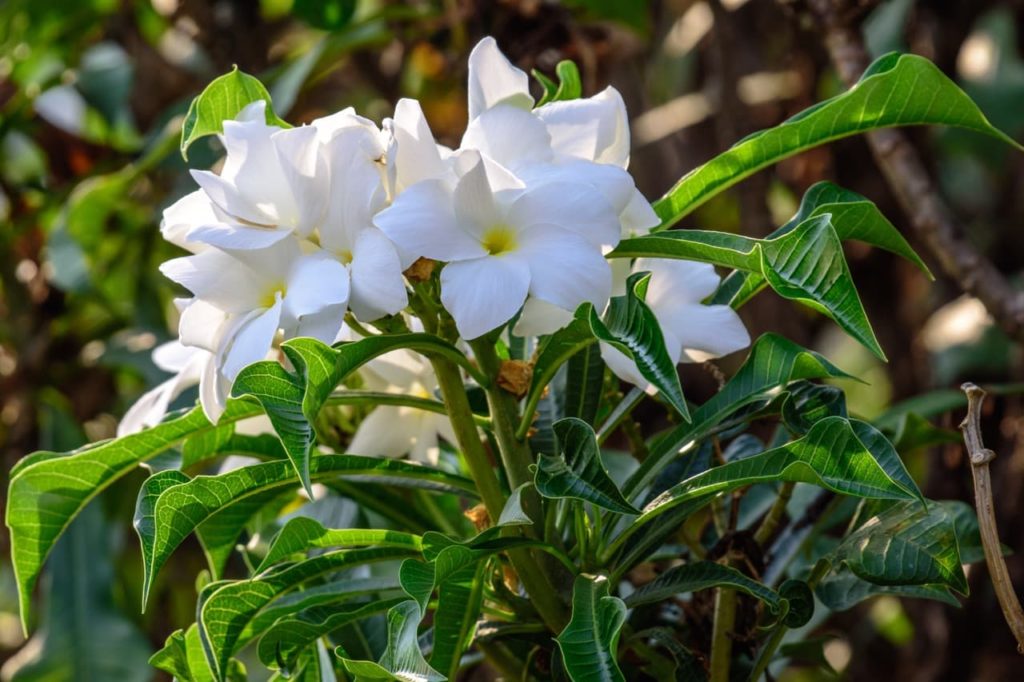
Common and highly regarded options to grow as houseplants in the UK include:
P. rubra ‘Aztec Gold’
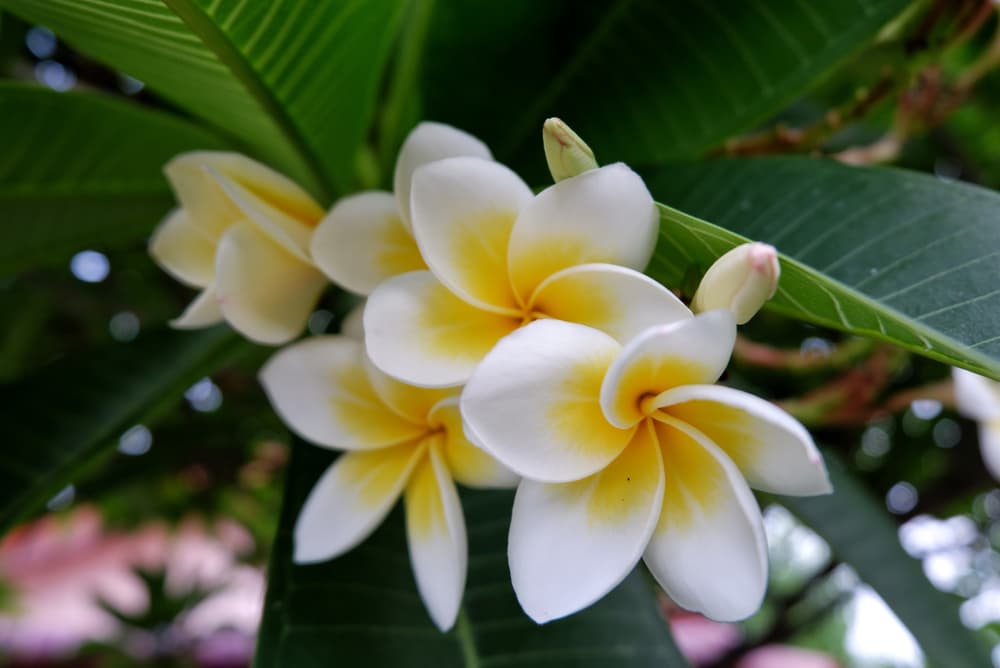
P. ‘Black Widow’
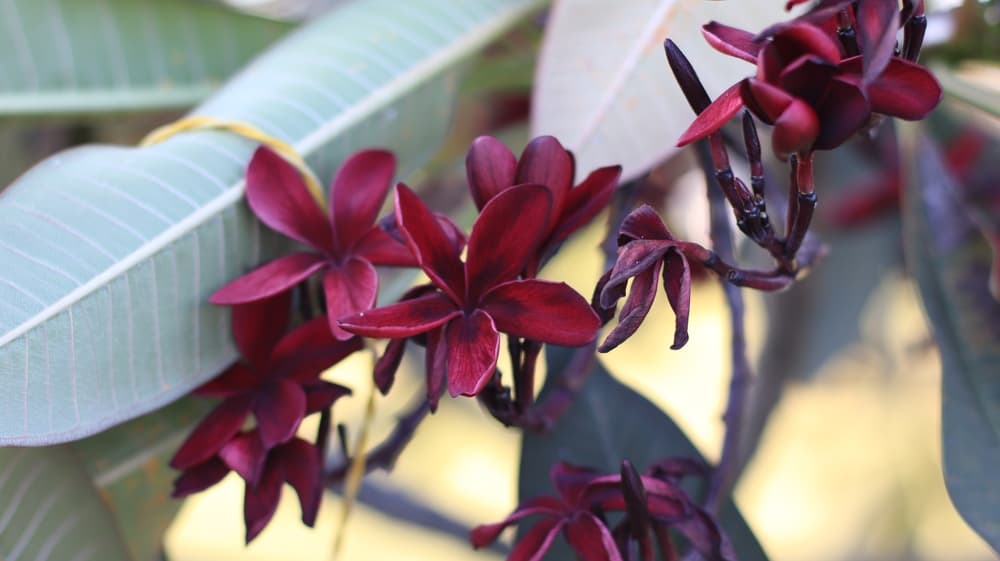
There are also plenty of other interesting cultivars to consider which have different coloured flowers or different foliage.
How To Grow Plumeria
Like other tropical houseplants, Plumeria can take some effort to grow.
It is also important that you choose a suitable location in which to grow it.
However, if the right environmental conditions are provided, this is a plant that can grow successfully indoors over a number of years.
Winter care can be especially important.
Plumeria can be planted up into pots or planted into the ground in a greenhouse border as long as that greenhouse remains warm enough throughout the year.
Frangipani should be placed in a bright location throughout the growing season, with temperatures that remain consistently above 15°C during the winter months, as at temperatures any colder than this, the growing tips can rot.
Soil Requirements
In containers, these plants should be provided with good quality, free-draining potting mix, such as John Innes no. 2, with some sharp sand or grit added to improve the drainage.
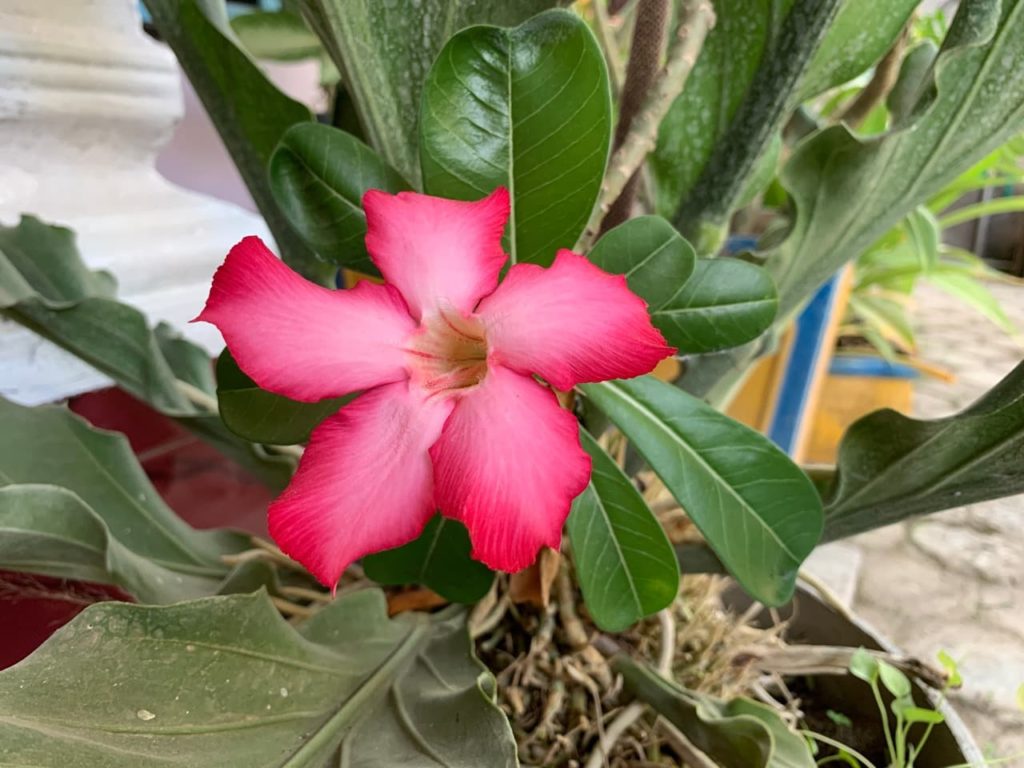
Every second year, the plants should be repotted and moved into a slightly larger container.
In alternate years when not repotting, the top 5cm of the growing medium should be removed and replaced with fresh compost.
Growing From Seed
Some Plumeria blossoms are infertile, so this is not typically a plant that is propagated by seed.
However, where seeds do develop, these can be sown in spring or summer and then covered over lightly.
They will need temperatures of 20-24°C for successful germination.
Frangipani Care
Keeping frangipani happy as a houseplant means understanding the care that they require and, crucially, how that care differs from one part of the year to another.
“I have grown Frangipani in an unheated conservatory, being careful to move it into a bright spot in the house from November to March,” shares Master Horticulturist Colin Skelly.
‘It can struggle with the change of light levels but recovers once back in the conservatory – on warmer winter days I will move it back into the conservatory to benefit from the light and then back inside as temperatures drop.”
Watering
Over the active growing season between spring and autumn, you should water freely when the Plumeria is dry.
However, take care not to overwater and ensure that excess water can drain away freely.
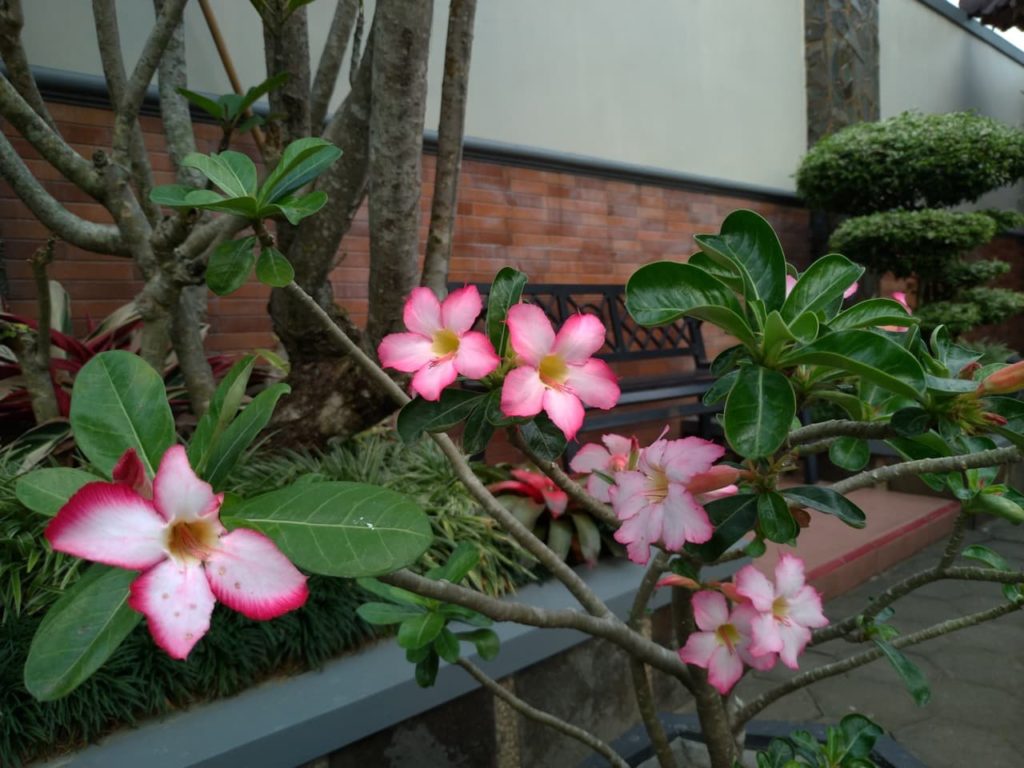
In winter, frangipani should be kept very dry.
In the coldest months, these houseplants should not be watered at all and should be treated in much the same way as cacti are over the winter months.
You should only start watering again from around the middle of March.
Feeding
Between April and the end of August, it is good practice to feed frangipani every couple of weeks with a balanced organic liquid feed, such as compost tea.
However, make sure that you do not feed these plants over the winter and leave it at least 5-6 weeks before you feed them again after repotting.
Pruning
It is best to avoid pruning Plumeria, as the wood is very soft and rot can set in easily.
If you absolutely must cut back some growth, then do this in early spring, towards the tail end of the dormant period before the plant returns to active growth.
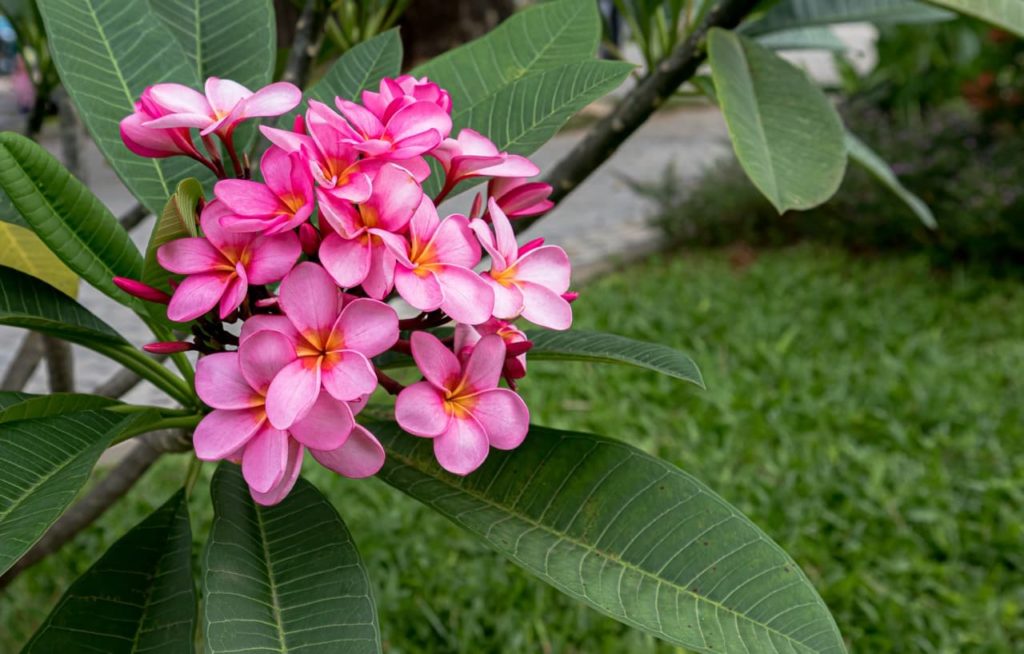
Cut back the growth that must be removed to where the next shoot or branch joins.
Generally, if plants are overgrown, they should be replaced, as they will not respond well to renovation pruning.
Propagating
Frangipani can be propagated by means of cuttings, which are best taken in February or March.
Cuttings around 10-15cm long should be taken from shoot tips.
These cuttings should then be left in a warm, dry spot for a couple of days for the ends to callus over.
Once the callus has formed over the cut end, the cuttings should be inserted into a free-draining compost mix and put into a propagator with bottom heat.
Keep the cuttings fairly dry, as excessive wet can cause them to rot.
In ideal conditions, the cuttings should root within 4-6 weeks.
Common Problems
Most of the problems encountered when growing Plumeria relate to environmental conditions.
For example, there may be problems if there is not enough light, temperatures drop too low, the conditions are too wet or too dry, or drainage is not sufficient.
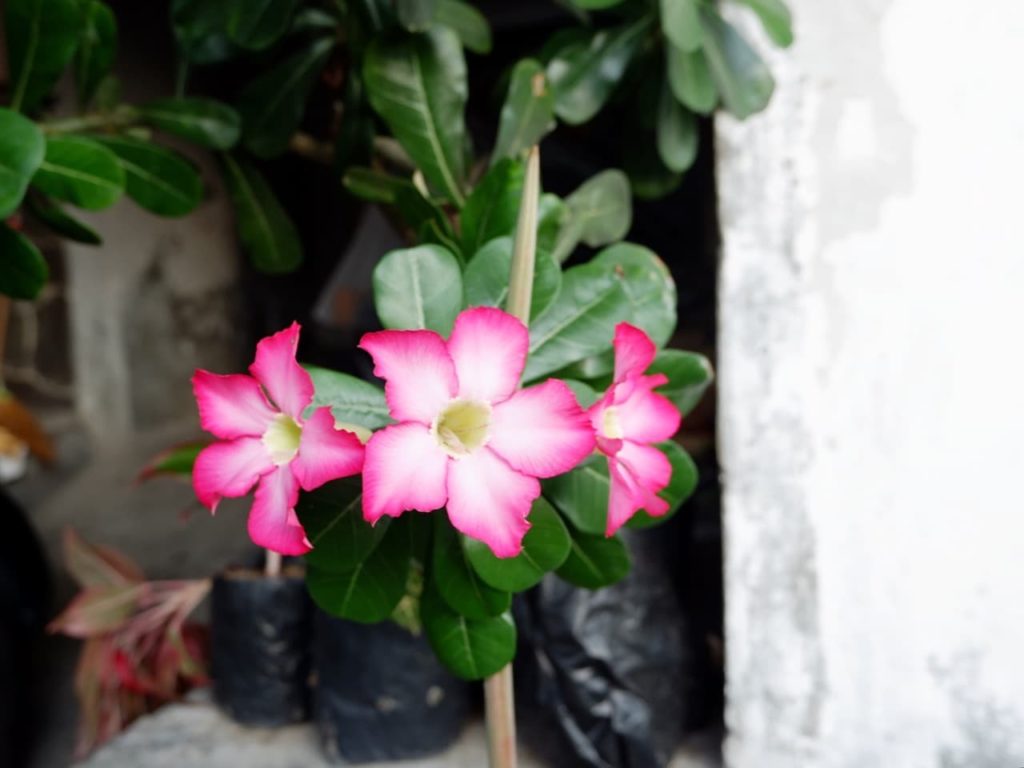
Red spider mites may also occasionally become problematic when growing this plant under glass.
References
- 1The BRAHMS Project, University of Oxford, Department of Plant Sciences. (n.d.). Plumeria rubra. Oxford University Plants 400: Retrieved June 14, 2023, from https://herbaria.plants.ox.ac.uk/bol/plants400/Profiles/op/Plumeria
- 2Tiernan, N. (2021, May 18). Taxonomy and Systematics of Plumeria L. (Apocynaceae) in the Caribbean Islands. FIU Digital Commons. Retrieved June 14, 2023, from https://digitalcommons.fiu.edu/cgi/viewcontent.cgi?article=6155&context=etd
- 3Plumeria Tourn. ex L. (n.d.). Kew Botanic Gardens. Retrieved June 15, 2023, from https://powo.science.kew.org/taxon/urn:lsid:ipni.org:names:30001863-2
